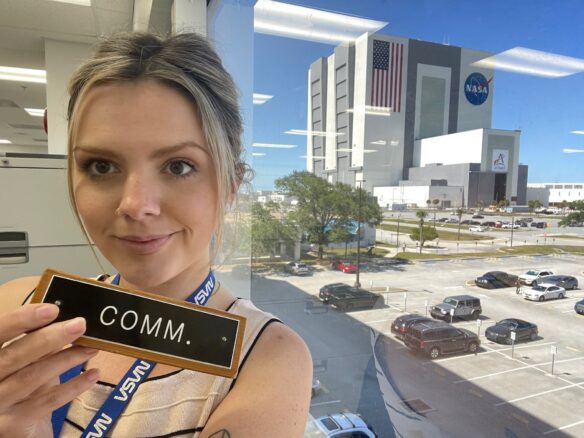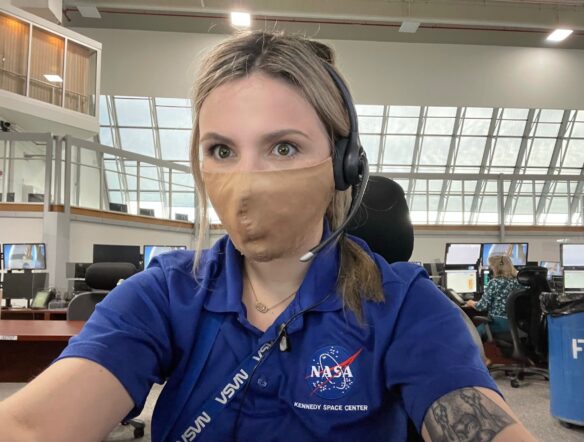
Alora Mazarakis, a graduate of Martha Layne Collins High School in Shelby County, is now an electronics engineer for NASA. She is part of the NASA team that helped launch the Artemis I mission this month. Her role is making sure the communication systems in the Orion spacecraft and the Space Launch System rocket work properly. Photo courtesy of Alora Mazarakis
Shelby County Public Schools graduate Alora Mazarakis remembers telling her father she wanted to go to college at NASA when she was young.
“You can’t go to college at NASA,” she said, “but that just kind of shows you what I was thinking as a kid.”
Reflecting on her role with the NASA team that helped launch the Artemis I mission this month, Mazarakis said being around the aerospace industry with her father while she grew up in Shelbyville led to her current role as an electronics engineer for the space agency.
“I always tell people when I was a kid, I wasn’t really playing with Barbie dolls,” she said. “I was playing with pilot Mickey and flight attendant Minnie, and airplane toys and solar system toys and things like that.”
The unmanned rocket will fly around the moon over the course of several days until it is expected to land back on Earth in the Pacific Ocean on Dec. 11.
After the first two launch attempts were canceled, the rocket finally was sent off on Nov. 16.
“It was such a breath of, I didn’t want to say relief, but just like so much excitement,” said Mazarakis.
Her role is making sure the communication systems in the Orion spacecraft and the Space Launch System rocket work properly.
Mazarakis graduated from Shelby County’s Martha Layne Collins High School in 2014. She has been working with NASA in various capacities since she was in college at the University of Louisville’s Speed School of Engineering, including a stint as a contractor working on the International Space Station for five years.
Her path to a formal education in the field started fairly late, though, and she compared her interest in aerospace to people who sing growing up.
“They like to sing, but people don’t really ever think they’re going to become professional singers or professional movie stars,” she said. “I mean, some people do, but it just seems like an imaginary job.”
Mazarakis joined Project Lead the Way while at Martha Layne Collins during her senior year, which allowed her to experience what it would be like to be an engineer.
Project Lead the Way is a nationwide program that provides hands-on courses for students, allowing them to play out real-life scenarios that engineers face every day in all kinds of situations.
“It’s just a great way to get students thinking, to get them really using critical thinking skills to develop something,” said Mazarakis. “Not just doing something to do it, like actually coming up with rationale behind why they’re designing a certain thing a certain way.”

Shelby County Public Schools graduate Alora Mazarakis on the job at NASA at the Kennedy Space Center in Florida. Photo courtesy of Alora Mazarakis
Scott Cress, a former teacher of Mazarakis’ at Martha Layne Collins High School who worked with Project Lead the Way as the school’s mathematics department chair, said the program enhances the student learning experience.
“Some of the students who are sitting on the outskirts that aren’t doing so successful, now you’re giving them something that’s tangible, and something they can build, something you can see,” he said. “And they’re given a chance to actually succeed in the classroom.”
Cress said Mazarakis was “extremely bright and extremely outgoing” as a student, and he is proud of what she is accomplishing.
“You want to see them succeed,” he said. “And as an ex-teacher of theirs, you just feel overly proud because it looks like seeing one of your own kids do well and succeed.”
Mazarakis said she is thankful for the people such as Cress that helped her live her childhood dream.
The Artemis I launch was Mazarakis’ first while supporting from the firing rooms, so she got to participate in a tie-cutting ceremony, a ritual that started with military pilots who would have their ties cut to signify their first flight and their ability to handle a plane on their own.
If Artemis I is successful, the next launch – Artemis II – will include a manned spacecraft conducting a similar trip around the moon. Artemis III will include a manned spacecraft landing on the moon for the first time since Apollo 17 in 1972.
The two trips are currently slated for 2024 and 2025, and Mazarakis plans to be there each step of the way.
“I’m just speechless because it’s so exciting to think that we’re going back to the moon,” Mazarakis said. “And this time, we’re not just going for political reasons, we’re not going to show other countries just that we can, we’re going for science.”
Some of the scientific observations astronauts will conduct while on the moon include sampling the ice, NASA scientists explained in 2019.




Leave A Comment